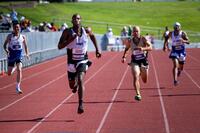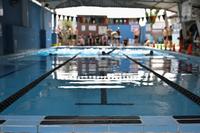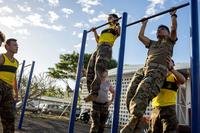Leading group PT can be a balancing act of selecting exercises that are useful for everyone. Some members want to improve on fitness tests, some are looking for general fitness improvements and others just want an opportunity to get outside and move more. All of these goals are reasonable and great for physical and mental health.
You must also balance intensity as you make it tough enough for the higher levels of fitness but not injure the lower end of the fitness spectrum or get them to fail too quickly. The more diverse your group, the more challenging this can be.
Here is a question from a PT coordinator who is looking for ideas for his unit as the weather changes.
Stew, I see you are still leading some big group PT at the Naval Academy! Do you have any ideas as a group PT leader for a group of moderate-to-advanced level athletes? I want to challenge them but not push too hard and injure them. That is my biggest problem for group PT, as it is either too hard for some or not hard enough for others. Any suggestions would be helpful. Thanks again. John P. (Navy)
Great question. I am still a guest PT instructor for a program called Summer Seminar run by the Naval Academy admissions department. It recruits high school students before their senior year who hope to attend the Naval, West Point or Air Force academies.
Group PT at this level is a delicate balance between too tough and not tough enough. Many are athletes, but not everyone does a lot of calisthenics and cardio. It's my responsibility to expose young men and women to military-style PT programs for the first time. I want it to be more educational than butt-kicking, but at the same time, I want them to work hard and realize they need to be in better physical shape should they consider making a service academy part of their military journey.
Check out this video on such a training session for how I run the 45-minute, no-equipment, PT session. We had to do this virtually due to COVID, but that gave us the opportunity to record it.
My advice is to start off the PT session with a short jog of five minutes or so. For the next phase of the warmup, try to line everyone up in a straight line on the field. Run 25-50 meters across the field, depending on the group size and distance of the field.
Do one push-up and one squat as a group. Run back to where you started (25-50 meters) and then do two push-ups and two squats. Continue this progression of reps to five. Assess the group.
People should have warmed up by now, and it is up to you if you continue up the pyramid to 10 push-ups and 10 squats or stop at five. The full pyramid yields a total of 55 push-ups and squats, which is a significant warmup that will have started to turn into a workout for many on the lower level of fitness.
Take a few minutes to do some light stretching and/or dynamic stretching, depending on the part of the body you plan on working during the next phase of the workout.
Try to mix in short bouts of running or jumping jacks to get the heart rate going above an easy talking pace. Follow the heart-raising events with some calisthenics to rest. You may find that placing the group members on their backs and doing a few core-based exercises is a good way to recover from the short bouts of running or jumping jacks.
Mix in flutter kicks, leg levers, crunches, hip rollers and plank poses, as well as what I like to call the PT reset exercises of reverse push-ups, birds, arm haulers and swimmers for 30 seconds each.
You want something that will challenge the group safely, and one of my new favorite challenges is the formidably titled Death By Push-ups (5-10 minutes). Since the Navy is now doing plank poses and push-ups for the fitness test, this is one event you cannot skip. Death By Push-ups is an exceptional way to prepare for both events in 5-10 minutes. Be warned that it will not feel like a short period of time, as time seems to stand still during the plank pose.
Do a five- to 10-minute plank (maybe build up to 10 minutes). But every minute on the minute (EMOM), choose one of these two options:
Advanced group members should do 10 push-ups EMOM during the plank pose.
Moderate levels of fitness can do a number of push-ups that match the minute number they are on each minute. For the first minute, they only do one push-up. The second minute, they do two push-ups ... and so on to minute five or 10, where you do five or 10 push-ups.
If you stop at five, that is 15 total push-ups. If you go to set 10, that is another 55 push-ups. Give "Death by Push-ups" a try, and the group will talk about it for the rest of the day as either a butt-kicker or a good challenge.
The key is to offer options so that people on a lower level of fitness can choose an easier exercise and keep up with the count. For instance, knee push-ups can be an easier version of push-ups. I prefer that people do knee push-ups when their push-ups turn to half push-ups or their form is poor. This allows them to do a full range of motion and get something out of the push-up set.
Another good option is a cooldown cardio session. Thas can be a run or a walk, depending on the group's fitness or whether there's pain from running injuries. Brief the route everyone is going to use to return to the department area. The running group can go a longer distance of 1-2 miles, while the walking group can walk for 10-15 minutes before returning to the work area.
Finally, check out more group PT videos on YouTube to get more ideas to keep your workouts from getting too stale. At the same time, make sure you're adhering to a few rules and offering different levels of intensity options and fun challenges.
Stew Smith is a former Navy SEAL and fitness author certified as a Strength and Conditioning Specialist (CSCS) with the National Strength and Conditioning Association. Visit his Fitness eBook store if you're looking to start a workout program to create a healthy lifestyle. Send your fitness questions to stew@stewsmith.com.
Want to Learn More About Military Life?
Whether you're thinking of joining the military, looking for fitness and basic training tips, or keeping up with military life and benefits, Military.com has you covered. Subscribe to Military.com to have military news, updates and resources delivered directly to your inbox.


















